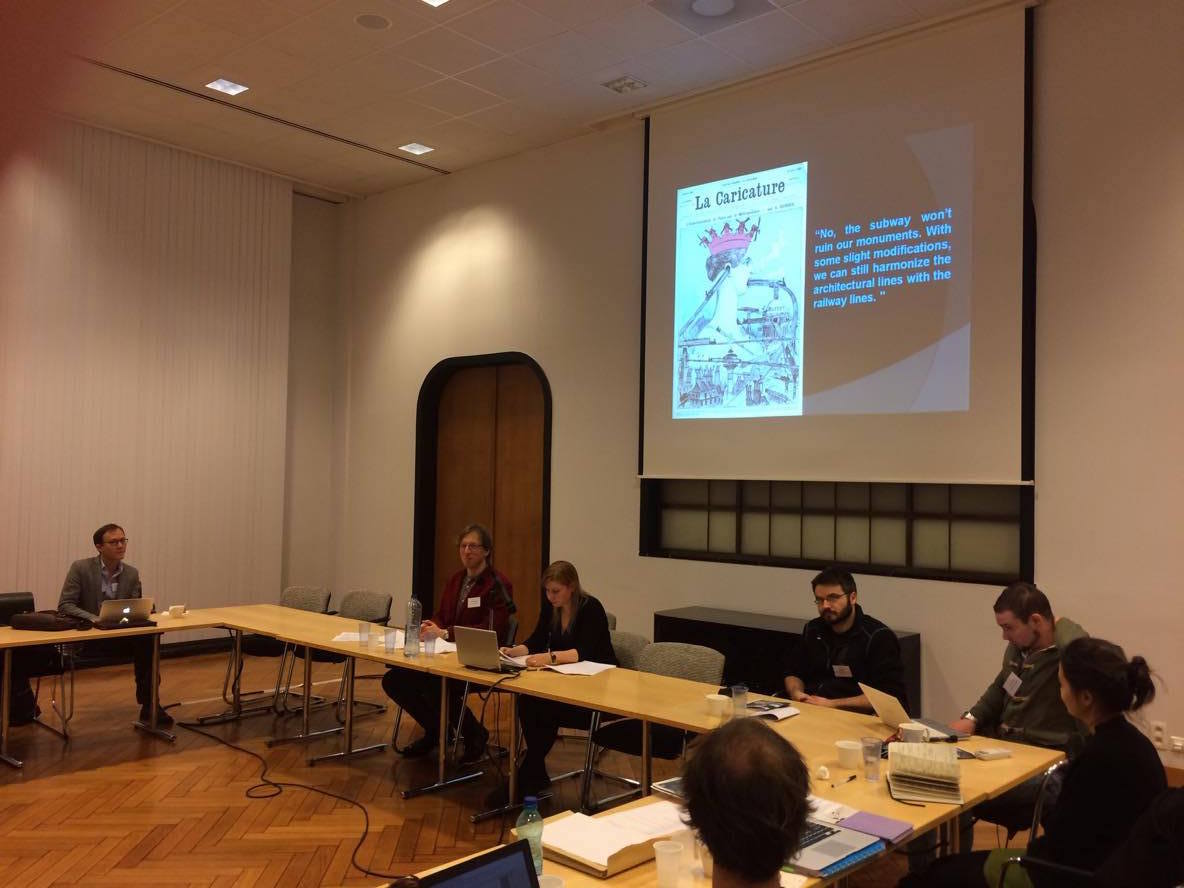CONFERENCE REPORT
Planned Obsolescence: Text, Theory, Technology
(Université de Liège, Belgium - December 8-9, 2016)
Ella Mingazova, Carole Guesse, Bruno Dupont
Chips blocking printers after a certain number of copies, smartphones getting more and more fragile, batteries suddenly losing their autonomy, food assigned an arbitrary expiration date: these are examples of the artificial limitation of the lifespan of consumable goods, in other words, a mechanism called “planned obsolescence,” which dates back at least as far as Bernard London’s 1932 pamphlet: “Ending the Depression through Planned Obsolescence.” Planned obsolescence was then presented as having a beneficial impact on society: forcing people to replace their belongings more rapidly would increase sales and thereby stimulate the economy. Throughout the twentieth and particularly during the twenty-first century, planned obsolescence as a business strategy has gradually gained a negative connotation and become a cause and a symbol of over-consumption (Latouche).
This change in value attached to the concept of planned obsolescence highlights its potential as a theoretical concept to help scholars consider the current cultural context, as it is governed by the expectation of the new and the celebration of innovation. Planned obsolescence could, for example, provide an explanation to the obsession for the new in critical theory that characterizes contemporary literary and cultural studies: any new theory is rapidly criticized by its detractors, who announce its replacement, often by adding to it the prefix “post” (post-structuralism, posthumanism, postmodernism and even post-postmodernism).
The central aim behind our international conference Planned Obsolescence: Text, Theory, Technology, which took place at the University of Liège (Belgium) on December 8th and 9th, 2016, was to test the potential for planned obsolescence to become an analytical tool. The conference focused on the possibilities of applying the concept of planned obsolescence in its broadest sense to domains as diverse as cultural theory, literature, media studies, philosophy and architecture. The conference was bilingual, with presentations both in French and English, providing a wide array of cultural and linguistic traditions, as speakers came from seven different countries. Crossing borders between different scientific traditions and disciplines, the conference was thoroughly interdisciplinary, allowing the weaving of some common threads and, thereby, stimulating the reflection on the concept of planned obsolescence.
Rethinking Obsolescence
This attempt extended the already existing but sparse research on obsolescence, as illustrated by Mathias Rollot’s recent book L’Obsolescence: ouvrir l’impossible (Obsolescence: Opening Up the Impossible). Rollot argues that the notion of obsolescence as a theoretical tool is radically different from the notion of destruction. For Rollot, obsolescence implies a change of meaning rather than a physical change (Rollot 17). Whether a clear distinction between these terms is viable through different disciplines and whether it is truly beneficial remains to be investigated. It could be argued that even objects struck by planned obsolescence are not destructed but become waste, which is very difficult to destruct.
Paradoxically, obsolete objects would then be objects that last. Likewise, as Jens Schröter explained in his presentation, implementing forgetting to digital media and permanently deleting information is much more laborious than making digital media remember. Everything that has ever been posted on the Internet always leaves a trace, even though it may no longer be accessible to the user. Surprisingly perhaps, most of the presentations focused on planned obsolescence as a phenomenon that does not imply destruction but rather a change in function, an altered relation between an object/subject and its environment, thereby reasserting the argument formulated by Mathias Rollot.
Keynote speaker Valérie Stiénon (Université Paris XIII - Pléiade) was invited to discuss the relation between planned obsolescence and speculative fiction. Her keynote address “Ni visionnaires, ni obsolètes: penser les récits d’anticipation dans l’histoire (littéraire)” (“Neither Visionary, nor Obsolete: Thinking about Speculative Fiction in (Literary) History”) dealt with archaic science fiction produced before the 1950s. Such writings are, perhaps more than any other genres, threatened by planned obsolescence: producing a narrative that imagines a possible future implies the risk of failure. Stiénon explained that archaic science fiction can be described as either visionary or obsolete. In visionary narratives, something is imagined as possible before it actually (and often much later) becomes real. This visionary quality is often partial, as most narratives only get some elements right. Many speculative narratives, however, are doomed to be obsolete as soon as they get old enough to be proven wrong. As highlighted by Stiénon, this visionary or obsolete quality is intrinsically linked with the social context of reception of these works.
Kathleen Fitzpatrick’s conclusion in her keynote address “The Future History of the Book: Time, Attention, Convention” ran along the same lines. She convincingly argued that our perception of the book as becoming obsolete with the advent of new (digital) media has more to say about the environment in which the book evolves than about the actual popularity of reading, a subject that she has discussed at length in her book The Anxiety of Obsolescence: The American Novel in the Age of Television (2006). Fitzpatrick was one of the first scholars to apply the notion of planned obsolescence to the humanities in her discussion of the future of academic publishing in Planned Obsolescence: Publishing, Technology, and the Future of the Academy (2011), in which she calls academic publishing “undead,” comparing it to a zombie: required, but non viable.
Renewal and the Obsolete
Obsolete objects and subjects are dormant awaiting revivification. The conference and particularly the presentations on video games (Julie Delbouille & Pierre-Yves Hurel), street art (Marjorie Ranieri) and materials used in tertiary buildings (Rémi Laporte) showed that what becomes obsolete does not die but stays in limbo, out-of-sync. Prior the conference, our main interrogation was: “Does every object, subject and concept contain the seeds of its own destruction?” As the conference progressed, the central question became “does every obsolete object, subject and concept contain the seeds of its own renewal?”
As highlighted by Vincent Beaubois in his presentation on the philosophy of Gilbert Simondon, no creation exists ex nihilo, and obsolete objects often serve as inspiration and would therefore be the necessary condition for innovation. This cyclical view was also present throughout the conference through the concept of repetition, which has been introduced from the very beginning of the conference, with Lee Nelson’s paper. It is through repetition that a product becomes a classic, as highlighted by Lilli Sihvonen in her paper on the Finnish game Kimble, and, as put forward by Kathleen Fitzpatrick, it is through reprints that a literary text becomes part of the canon. The singularity of each object is erased for the benefit of the immortality of the product. In the same line of thought, planned obsolescence reveals itself as a relevant concept in discussions on therapeutic cloning – a topic that did not come up during the conference.
Our discussion of planned obsolescence extended beyond objects and encompassed humans as well, either in the form of suicide as in Nadia-Terese Franks’s presentation on DeLillo’s Zero K and Atwood’s Oryx and Crake or in the form of retirement as in Edouard Jolly’s presentation on Günther Anders and his work Die Antiquiertheit des Menschen (The Obsolescence of Humankind). While the latter is akin to a mechanism of self-destruction, the former is a change in function: the retired human has not become obsolete but no longer fulfill his or her function as a worker.
The variety of the contributions at Planned Obsolescence: Text, Theory, Technology showed that planned obsolescence can be a useful tool for theoretical thinking on numerous topics in disciplines as diverse as media studies, literary history, art history, philosophy, and game studies. During this two-day conference, we have done some groundwork but more research is needed to develop the full potential of planned obsolescence as a solid theoretical tool. We, therefore, hope to see more discussions on this subject in the future.



Works Cited
Fitzpatrick, Kathleen. The Anxiety of Obsolescence: The American Novel in the Age of Television. Nashville: Vanderbilt University Press, 2006.
Fitzpatrick, Kathleen. Planned Obsolescence: Publishing, Technology, and the Future of the Academy. New York: New York University Press, 2011.
Anders, Günther. Die Antiquiertheit des Menschen. München: C. H. Beck, 1956.
Latouche, Serge. Bon pour la casse: Les déraisons de l’obsolescence programmée. Paris: Les liens qui libèrent, 2012.
London, Bernard. “Ending the Depression through Planned Obsolescence.” 1932. Web. <https://upload.wikimedia.org/wikipedia/commons/2/27/London_%281932%29_Ending_the_depression_through_planned_obsolescence.pdf> .
Rollot, Mathias. L’Obsolescence: ouvrir l’impossible. Geneva: MétisPresses Éditions, 2016.
Ella Mingazova is a doctoral student at the University of Liège and the KU Leuven, Belgium. She has graduated from UCLouvain, Belgium, in 2014. Her research focuses on duration, aesthetic slowness and scales in contemporary fiction. She has been a visiting scholar at Project Narrative (Ohio State University, United-States) in Fall 2016. She has co-organized the conference Planned Obsolescence: Texts, Theory, Technology (Liège, December 2016).
Carole Guesse is a doctoral student at the University of Liège, Belgium, where she obtained a Master’s degree in English and Hispanic Studies. She is preparing a PhD dissertation on the poetics of the posthuman, with a focus on novels by Michel Houellebecq, Margaret Atwood and Andri Snær Magnason. Her research interests include poetics, literary and cultural theories, literary genres, science fiction, posthumanism and transhumanism. She has co-organized three conferences: Planned Obsolescence: Texts, Theory, Technology (Liège, December 2016), The 9th Beyond Humanism Conference (Rome, July 2017), and Narratives of the Posthuman Body (Utrecht, July 2017).
Bruno Dupont is a research assistant at the University of Liège, and is currently working on a doctoral thesis in German literature. His project aims to assess the influence of the depiction of the computer on the form and content of contemporary German texts. He is interested in the relation between literary and game studies, as well as in emerging literary genres which try to take the digital turn into account. He has published on these topics in French and German and has been a member of the Liège Game Lab since 2016. He has co-organized the conference Planned Obsolescence: Texts, Theory, Technology (Liège, December 2016).

